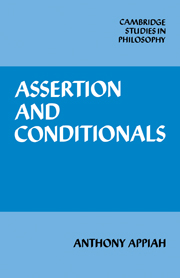Book contents
- Frontmatter
- Contents
- Acknowledgements
- Notation
- 1 Cartesianism, behaviourism and the philosophical context
- Part I Belief
- Part II Meaning
- Part III Conditionals
- 8 Indicative conditionals
- 9 Truth and triviality
- 10 Logic without truth
- 11 Generalising the probabilistic semantics of conditionals
- Epilogue
- Bibliography
- Index of names
- Index of key terms
9 - Truth and triviality
Published online by Cambridge University Press: 07 October 2011
- Frontmatter
- Contents
- Acknowledgements
- Notation
- 1 Cartesianism, behaviourism and the philosophical context
- Part I Belief
- Part II Meaning
- Part III Conditionals
- 8 Indicative conditionals
- 9 Truth and triviality
- 10 Logic without truth
- 11 Generalising the probabilistic semantics of conditionals
- Epilogue
- Bibliography
- Index of names
- Index of key terms
Summary
Touchstone: … Your ‘if’ is the only peace-maker: – much virtue in ‘if’.
(As You Like It, Act V, Scene iv)OVERVIEW
AH: ‘If A, C’ is assertible iff p(C:A) is high.
That is my claim. Once accepted, there is, as we have seen, good reason for thinking that the indicative conditional is not a material conditional. Indeed, since it is easy to see that no truth-function of two components has a probability equivalent to the conditional probability, there is good reason for thinking that the indicative conditional is not a truth-function at all. But the fact that it is not a truth-function is not, in itself, evidence that it has no truth conditions. The sentence-forming operator on sentences ‘I believe that …’ is not a truth-function: but there is no reason to doubt that it determines truth conditions, or to doubt that grasp of how those truth conditions are determined is part of a knowledge of what it means.
Since, in general,
ASS: ‘S’ is assertible iff p(S) is high, where S has truth conditions
it is tempting, given the strong evidence that Adams' assertibility rule is correct, to look for a set of truth conditions for ‘If A, then C’, such that the sentence is assertible iff it is believed to be probably true.
- Type
- Chapter
- Information
- Assertion and Conditionals , pp. 192 - 212Publisher: Cambridge University PressPrint publication year: 1985



